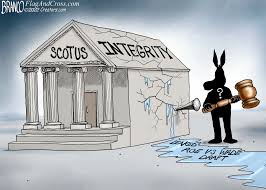Recent decisions by the U.S. Supreme Court have sparked a heated debate about the role that the institution should play in interpreting the U.S. Constitution and the wording of the secondary laws that give it viability.
The overturning of abortion rights and affirmative action, along with the refusal to forgive the debt of college students from low-income backgrounds, has provoked widespread disdain in U.S. society, particularly among women, people of color, and the Latino community, and more generally across the working-class population.
The discussion about the propriety of such decisions and the basis upon which the court’s six conservative judges made them has been both prolific and enlightening. The conversation has evolved to the point where the question is: What role does the Supreme Court play in modern society? It is clear from its recent activism around controversial issues such as abortion and affirmative action, and a not-so-distant past [decision on] financing election campaigns, that some of its members prefer to act like members of a political party rather than the impartial judges that they ought to be. Its traditional role of overseeing and balancing the executive and legislative branches is a thing of the past and it is increasingly evident that its interpretation of the Constitution is tainted by the ideology of its more conservative members. This, in turn, becomes an obstacle which hinders the modern aspirations of a society that refuses to be anchored to the past. Nowadays, the court seems to operate against the will of most of society. Before her death, distinguished jurist Ruth Bader Ginsburg lamented that the court had become an obstacle to social progress and the reforms that had come about because of that progress.
How to fix the court is the question asked by legal reporter Linda Greenhouse, who has written extensively on the contemporary history of the grand jury (NYT, July 10). In her article she details some of the conclusions arrived at by the commission created by President Joe Biden to improve the current situation of said institution. “How should we think about the Court today — its extraordinary power, the agenda of its new conservative supermajority … The amount of power individual justices wield over American life should concern policymakers, lawyers, and citizens of all political and ideological perspectives … Across the span of American history, the Supreme Court has most often been the obstacle to progress; as some witnesses emphasized, for reasons of practice and structure it is highly likely to remain so.”*
According to different experts, the court has lost the traditional respect in which it was held and has instead become a launch pad for conservatives committed to policies that limit the rights of minorities. Even more concerning, however, is the way that some of its judges have violated the ethics that they must have inside and outside the institution. The way in which they trivialize the meaning of the privileges that they receive from those who are part of the disputes that they resolve is scandalous. To quote one of the most senior federal judges who appeared in last week’s New York Times, in a country of more than 330 million people, 1,500 people make up the federal judiciary and the integrity with which the latter group conduct themselves is the perception that society has not only of them, but of the judiciary in general. With respect to the U.S. Supreme Court, sadly, some of its members have undermined people’s confidence in this great seat of justice. What happened to the court is the final question that must be asked.
*Editor’s Note: This quote, accurately translated, could not be independently verified.
Shop For Night Vision | See more…
Shop For Survival Gear | See more…
-
Sale!

Quick Slow Release Paramedic Survival Emergency Tourniquet Buckle
Original price was: $14.99.$7.99Current price is: $7.99. Add to cart -
Sale!

Mesh Shooting Hunting Vest with Multi Pockets
Original price was: $59.99.$39.99Current price is: $39.99. Add to cart -
Sale!

Portable Mini Water Filter Straw Survival Water Purifier
Original price was: $29.99.$14.99Current price is: $14.99. Add to cart

















































